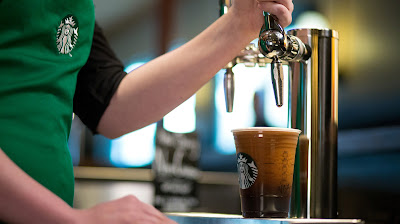In cold brew coffee, grinds are infused into cold water to make a strong brew that reduces acidity and bitterness. Some coffee roasters have started using nitrogen gas to amp up their cold brew coffee's silky texture and add a creaminess to the basic black brew. The resulting nitro coffee has creamy, sweet, and smooth flavors without added milk or sugar -- although these can be added to taste. While nitrogen coffee offers a cool factor that's rapidly gaining converts, it isn't without risk.
How Nitro Brew is Made
It all starts with the cold brew, where coffee grinds soak in distilled water to create a rich coffee concentrate. The mixture is then diluted with water. Coffee lovers claim cold brew coffee tastes better than hot coffee, because it captures the flavors of the brew without the acidic notes. The underlying fruity, floral, or spices notes within the coffee are allowed to shine for a deeper coffee drinking experience.
In a nitro coffee process, nitrogen gas is added to the cold brew coffee. This can happen during canning or bottling, which creates a shelf stable product, or coffee shops can use a tap system to infuse cold brew with nitrogen. In either case, when nitrogen meets the water content in coffee, it doesn't dissolve readily, as another gas might. This gives the nitro coffee a rich mouthfeel and a creamy head, mimicking the creamy flavor of coffee with cream without the dairy. Tiny bubbles of nitrogen gas make the drink thicker for a better mouthfeel. It's almost like a dessert version of iced coffee, especially when the nitro coffee is served with sugar syrup and cream -- or as the base for an ice cream soda.
While nitrogen gas enhances the flavor of coffee, there are risks associated with using this gas to infuse coffee. Nitrogen gas displaces oxygen from the environment -- part of the reason it makes that coffee taste so good -- and this can cause health hazards if the gas leaks into the air.
Coffee shops that serve nitrogen coffee on tap or bottle the beverage for consumption must worry about the potential for a nitrogen gas leak. If a nitrogen dewar or supply line were to develop a leak, the leaking gas would reduce oxygen levels in the room. Since nitrogen has no color or odor, there is no way for employees or customers to know there is a leak.
If the oxygen levels fall so low that the air is unsafe to breathe, employees and customers can experience respiratory distress, cognitive confusion or -- in a worst case scenario -- death via asphyxiation. One simple safety device can monitor oxygen levels to ensure there's enough breathable air in the room and provide sufficient warning of a nitrogen leak.
How an Oxygen Monitor Protects Public Health
By installing an oxygen monitor anywhere that nitrogen gas is stored or used, coffee shops can protect against the risks of a nitrogen leak. Oxygen monitors continually sample the air to determine oxygen levels. As long as the air has enough oxygen, the monitor remains silent. If levels of oxygen in the air fall to OSHA's critical threshold, which would suggest that nitrogen gas is displacing oxygen, the monitor will flash lights and sound a 90-decibel alarm to warn people of the imminent health threat. Staff and customers can then leave the cafe until emergency personnel arrive to contain the nitrogen leak.
PureAire's alarm has a digital display, which shows a constant readout of oxygen levels in the room. This can provide peace of mind that everything's working properly. Since these oxygen monitors resist drift from thunderstorms, barometric shifts or other incidents, they are reliable all year round.
PureAire's line of oxygen monitors feature robust zirconium sensors, which last for 10+ years. PureAire products require no maintenance or calibration once set up, and offer a low-maintenance and long-lasting alternative to other oxygen monitors. To learn more about PureAire's products, please visit www.pureairemonitoring.com.











